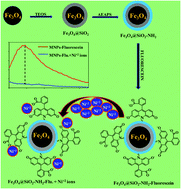当前位置:
X-MOL 学术
›
J. Mater. Chem. C
›
论文详情
Our official English website, www.x-mol.net, welcomes your
feedback! (Note: you will need to create a separate account there.)
Sensitive fluorescence detection of Ni2+ ions using fluorescein functionalized Fe3O4 nanoparticles
Journal of Materials Chemistry C ( IF 5.7 ) Pub Date : 2017-12-29 00:00:00 , DOI: 10.1039/c7tc04298a M. T. Shah 1, 2, 3, 4, 5 , A. Balouch 6, 7, 8 , E. Alveroglu 1, 2, 3, 4, 5
Journal of Materials Chemistry C ( IF 5.7 ) Pub Date : 2017-12-29 00:00:00 , DOI: 10.1039/c7tc04298a M. T. Shah 1, 2, 3, 4, 5 , A. Balouch 6, 7, 8 , E. Alveroglu 1, 2, 3, 4, 5
Affiliation

|
This study describes a very sensitive fluorescence sensor for the selective nanomolar detection of Ni2+ ions. The Ni2+ ion sensing is based on fluorescence quenching of the fluorophore (fluorescein) in neutral aqueous medium. The fluorescence sensor is composed of a magnetic core and amino silica shell, functionalized with a fluorescein fluorophore. The morphology, physical and chemical properties of the sensing materials were studied by FT-IR spectroscopy, X-ray powder diffraction, vibrating sample magnetometer (VSM) and Transmission Electron Microscopy (TEM). UV-visible and fluorescence spectroscopy were used to characterize the fluorescein functionalized magnetic nanoparticles. The characterization measurements revealed that the fluorescent nanostructures were superparamagnetic in nature with an average particle diameter of 10 nm. The as-fabricated fluorescent nanosensor (Fe3O4@SiO2-NH2-fluorescein) showed an enhanced fluorescence quenching response towards Ni2+ ions in neutral pH medium. The response of the nanosensor was highly selective towards the target species whereas the possible interferences from other metal cations and biological molecules were negligible. The fluorescein probe has a very fast response, it is selective and has a sensitive detection limit (LOD = 0.83 nM) towards Ni2+ ions in neutral medium with a high binding constant (K) value of 3.2 × 104 M−1 for the complex formation between the sensor and Ni2+ ions. These features ensure the potential use of fluorescein functionalized magnetic nanomaterials as a new class of non-toxic biocompatible sensors for biological and environmental applications.
中文翻译:

使用荧光素官能化的Fe 3 O 4纳米粒子 灵敏地检测Ni 2+离子的荧光
这项研究描述了一种非常灵敏的荧光传感器,用于选择性纳摩尔检测Ni 2+离子。镍2+离子感测基于中性水性介质中荧光团(荧光素)的荧光猝灭。荧光传感器由磁芯和氨基硅胶壳组成,并用荧光素荧光团功能化。通过FT-IR光谱,X射线粉末衍射,振动样品磁力计(VSM)和透射电子显微镜(TEM)对传感材料的形貌,物理和化学性质进行了研究。紫外可见光谱和荧光光谱用于表征荧光素官能化的磁性纳米粒子。表征测量结果表明,荧光纳米结构本质上是超顺磁性的,平均粒径为10 nm。制成的荧光纳米传感器(Fe 3 O 4 @SiO 2-NH 2-荧光素)在中性pH介质中显示出对Ni 2+离子增强的荧光猝灭响应。纳米传感器对目标物种的反应具有高度选择性,而来自其他金属阳离子和生物分子的可能干扰则可以忽略不计。荧光素探针具有非常快的响应,它是选择性的,并且具有灵敏的检测限(LOD = 0.83 nM)的朝向的Ni 2+在具有高结合常数(中性介质中离子ķ的3.2×10)的值4中号-1为传感器和Ni 2+之间的复杂形成离子。这些功能确保了将荧光素功能化的磁性纳米材料潜在地用作生物和环境应用中的新型无毒生物相容性传感器。
更新日期:2017-12-29
中文翻译:

使用荧光素官能化的Fe 3 O 4纳米粒子 灵敏地检测Ni 2+离子的荧光
这项研究描述了一种非常灵敏的荧光传感器,用于选择性纳摩尔检测Ni 2+离子。镍2+离子感测基于中性水性介质中荧光团(荧光素)的荧光猝灭。荧光传感器由磁芯和氨基硅胶壳组成,并用荧光素荧光团功能化。通过FT-IR光谱,X射线粉末衍射,振动样品磁力计(VSM)和透射电子显微镜(TEM)对传感材料的形貌,物理和化学性质进行了研究。紫外可见光谱和荧光光谱用于表征荧光素官能化的磁性纳米粒子。表征测量结果表明,荧光纳米结构本质上是超顺磁性的,平均粒径为10 nm。制成的荧光纳米传感器(Fe 3 O 4 @SiO 2-NH 2-荧光素)在中性pH介质中显示出对Ni 2+离子增强的荧光猝灭响应。纳米传感器对目标物种的反应具有高度选择性,而来自其他金属阳离子和生物分子的可能干扰则可以忽略不计。荧光素探针具有非常快的响应,它是选择性的,并且具有灵敏的检测限(LOD = 0.83 nM)的朝向的Ni 2+在具有高结合常数(中性介质中离子ķ的3.2×10)的值4中号-1为传感器和Ni 2+之间的复杂形成离子。这些功能确保了将荧光素功能化的磁性纳米材料潜在地用作生物和环境应用中的新型无毒生物相容性传感器。











































 京公网安备 11010802027423号
京公网安备 11010802027423号